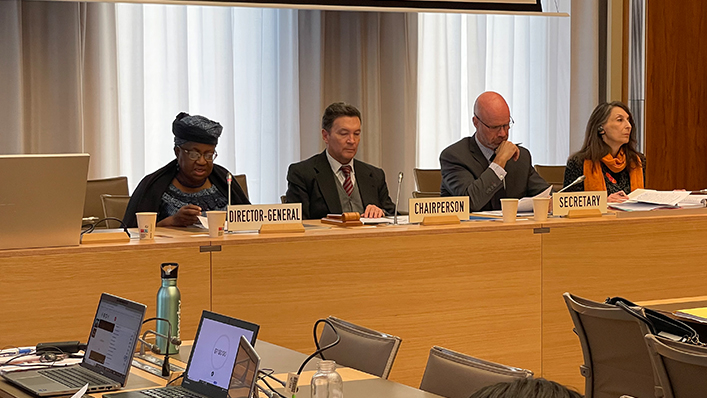
Excellencies, ladies and gentlemen. I am pleased to join you today to take stock of recent trade policy developments.
Thank you, Ambassador VILLALOBOS (Mexico) for your introductory remarks.
You all will have seen my Report which was circulated to Members on 22 November, in document WT/TPR/OV/25.
Ambassador VILLALOBOS has already described how the Report was prepared.
Allow me to share with you my key take-aways from the Report, and to point to a few issues we have been watching closely since the mid-October close of the review period.
The global economy continues to face multiple challenges: continuing impacts of the pandemic, the repercussions of the war in Ukraine, high inflation – particularly for food and energy prices, and several climate change-related events that disrupted economic activity. In October we downgraded our outlook for international trade: we now forecast merchandise trade volumes will grow by just 1.0% in 2023, well below the 3.4% we had estimated in April.
The Report shows that since 2020, Members have increasingly implemented new trade restrictions, in particular on the export side, first in the context of the pandemic and more recently in the context of the war in Ukraine and the food security crisis.
Although some of these export restrictions have been lifted, many others persist. The Secretariat’s ongoing monitoring shows that as of 24 November 2022, out of the 78 export restrictive measures on food, feed, and fertilizers introduced since the start of the war in late February, 58 are still in place, covering roughly USD 56.6 billion of trade. These numbers have increased since mid-October,and I’ve highlighted them repeatedly both at the General Council as well as in various international meetings- especially at the G20, because I believe it’s a cause for concern
As I told G20 Leaders at their summit in Indonesia a few weeks ago, lifting those export restrictions is fundamental to reduce price spikes and volatility and to allow goods to flow to where they are urgently needed.
With respect to the pandemic, the Report shows how trade policy helped in efforts to combat COVID-19. Global value chains held up, despite initial disruptions, and the multilateral trading system played an instrumental role in encouraging restraint in the use of trade restrictions in response to pandemic-related shocks. Most of the 443 COVID-19-related trade measures on goods introduced by WTO Members and Observers since the outbreak of the pandemic were trade facilitating, and this is a very good point.
During the mid-October 2021 to mid-October 2022 review period, Members continued to phase out pandemic-related measures, in particular restrictive ones. Nevertheless, 41 pandemic-related trade restrictions remain in place (27 export- restrictions and 14 import-restrictions), covering USD 134.6 billion worth of trade, according to information received by the Secretariat. As we look to improve access to vaccines, therapeutics, diagnostics, and other critical medical supplies globally, I urge members to end the remaining restrictions.
On a positive note, the number of new COVID-19-related measures on goods and services has decreased significantly over the past year. But pandemic-related shocks are still with us, and so there is a need for continued vigilance.
Another challenge which merits our attention, even if it does not make news headlines, is the slow but steady growth in the stockpile of import restrictions that have accumulated since the Trade Monitoring exercise began in 2009. As of mid-October 2022, some 9% of global imports were affected by import restrictions introduced since 2009 and still in force. The failure to roll back these measures is detrimental to the efficient functioning of global commerce, and we need to gain a better understanding of what can be done to reduce this stockpile.
Before concluding, I want to note that the Report also includes an overview of the status of notifications across WTO bodies, an issue which I know is of great interest to Members and continues to merit close scrutiny, particularly as we work to move ahead in our discussions about reforming this and other pillars of the WTO’s work.
In closing, let me reiterate that the Trade Monitoring Exercise – a unique multilateral and cross-cutting endeavour – is only as strong as Members want it to be. In other words, your participation is crucial. I thank all those that have participated in this important work, and urge all delegations to join in and help us strengthen this transparency exercise. I think the most favourite word in use at the WTO is transparency, so if we’re really going to do this and be transparent, we need everyone to participate in this exercise.
The Secretariat has continued its outreach program to help delegations and capitals better understand what the exercise entails. In response to feedback from delegations, the Secretariat has developed a digital platform for on-line verification where Members can voluntarily participate and verify their measures. The online platform is still under development and is part of the Trade Monitoring Database. Early next year the Secretariat will get in touch with interested Members to provide guidance and feedback on how online verification is working. I urge Members to take advantage of this new development and participate more in the exercise.
Finally, I encourage you to also have a look at the 3-page Fact Sheet on the Report – a quick overview that the Secretariat has prepared and posted on the WTO website.
Unfortunately, I will not be able to stay with you this afternoon, but DDG Ellard will be here and will be able to report back to me on your exchanges and suggestions. So thank you very much and I wish you a fruitful deliberation this afternoon.
Reach us to explore global export and import deals